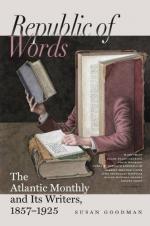The best part of the volume of memoirs is made up of Seddon’s letters from the East. They exhibit his character in a most agreeable light, while, apart from any personal interest, they have a charm, as natural, vivid delineations of Eastern scenery and modes of life. He saw with a painter’s eye, and he described what he saw clearly and vigorously, showing in his letters the same traits which he displayed in his pictures. Writing from his camping-ground on the edge of the Desert, he says,—“The Pyramids and Sphinxes, in ordinary daylight, are merely ugly, and do not look half as large as they ought to look from their real size; but in particular effects of light and shade, with a fine sunset behind them, for example, or when the sky lights up again, a quarter or half an hour afterwards,—when long beams of rose-colored light shoot up like a glory from behind the middle one into a sky of the most lovely violet,—they then look imposing, with their huge black masses against the flood of brilliant light behind.”
Here is the first sight of Jerusalem:—“At length, about five o’clock, after expecting, for the last half-hour, that every hill-side we climbed would be the last, we came suddenly in full view of Jerusalem.—Few, I think, however careless, have looked for the first time on this scene, without some feelings of solemn awe. We read the accounts of all that passed within or around these walls with something of the vagueness that always veils the history of times that have gone by two thousand years ago; but however soon the feeling may wear off or be cast away, it is impossible, with the very spot before you where your Saviour lived and died, not to feel vividly impressed with the actual reality of what we have read of, and its intimate connection with ourselves.—But soon I was struck with the very erroneous idea I had had of Jerusalem. From the west it does not look at all like a city built on a hill; for, rather below you, at the farther end of a barren plain, you see nothing but the embattled walls of a feudal town, with one or two large buildings and a minaret alone visible above them. To the right the ground dips into the Valley of Hinnom,—but to the left it is level with the city-walls, and its surface is covered with bare ribs of rock running along it; and it is from this side that the Romans and Crusaders attacked. Behind the city, rather to the north, lay the Mount of Olives, and the long, straight lines of the Moab Mountains beyond the Dead Sea, stretching from horizon to horizon, half-shadowy and veiled in mist, through which they shone rosy in the evening’s sunlight.”
We have no space for further descriptions, excellent as they are. But we make one or two extracts relating more immediately to Art and to Seddon’s views of the duties of an artist.
“I am sure that there is a great work to do, which wants every laborer,—to show that Art’s highest vocation is, to be the handmaid to religion and purity, instead of to mere animal enjoyment and sensuality. This is what the Pre-Raphaelites are really doing in various degrees, but especially Hunt, who takes higher ground than mere morality, and most manfully advocates its power and duty as an exponent of the higher duties of religion.”




